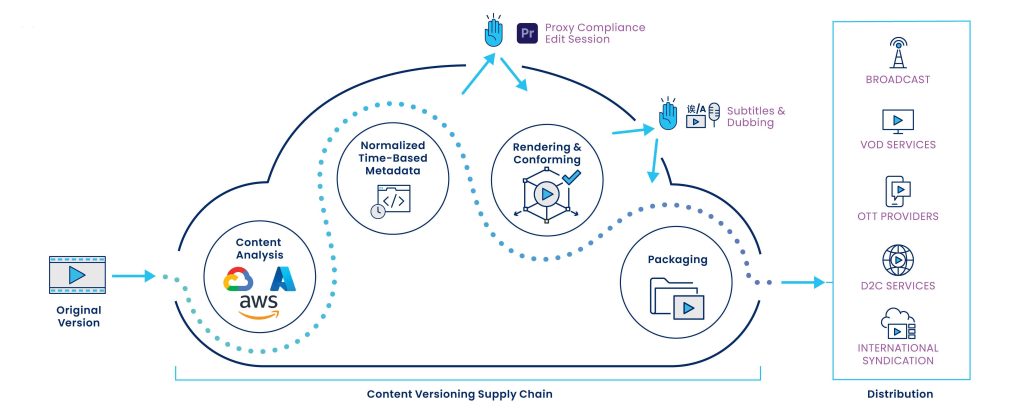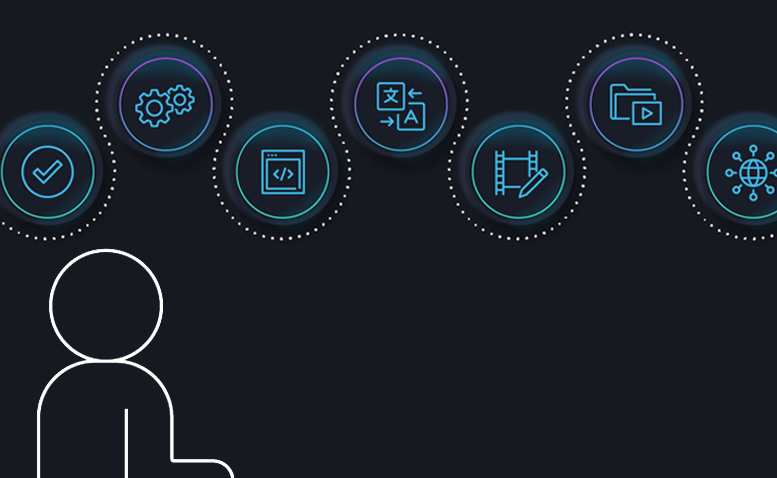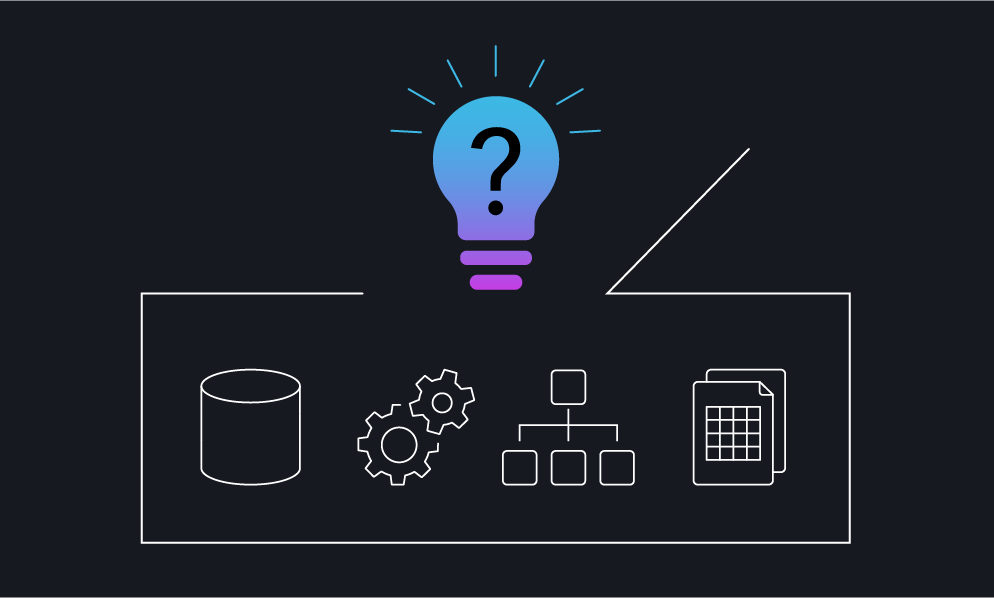At IBC2022, SDVI was part of a consortium of companies that published the Cloud Localization Blueprint (CLB). The project was an opportunity for vendors to map out cloud-based content localization workflows and, more specifically, how those workflows can be automated, orchestrated, and accelerated from the time a deal is signed to the moment localized content is delivered.
Our goal was to help media organizations to minimize time to revenue and maximize the relevancy of content for global distribution, using the cloud — again, with the benefit of automation and orchestration — to streamline that process as much as possible. The blueprint itself provides a useful framework for cloud-based supply chain integration, serving as a model implementation that demonstrates best practices using best-in-class vendors and partners.

The need for a new model.
Content localization is a particularly compelling target for optimization because fast, cost-effective localization enables media organizations to move faster in delivering culturally relevant content to new markets and audiences. Content attracts and keeps viewers when it is culturally relevant, when it speaks their language and conforms to their needs and cultural standards. And, as we all know, demand for relevant content is immense and only growing.
Global media consumers expect that content produced in other places — and particularly in dominant content-producing markets such as the U.S. and U.K. — will be made accessible to them. They also expect that it will have some of their own region’s attributes, be that a dubbed language track, subtitles, or even cultural references. What’s more, they expect that those elements will be additive, not an afterthought. Along with other improvements to audio and video, such as higher resolution and advanced audio technologies, they expect a dub of good quality, subtitles that are correct, and so on.
Traditionally, adding these elements, creating new versions from original assets, and managing packaging in the appropriate formats and profiles has been a labor-intensive process, and thus a costly one too. With the rapid expansion of global audiences and explosion in demand for content, however, efficient high-volume localization has become a critical enabler of new business opportunities.
Combining automated and artistic processes as it does, localization will never be a perfectly repeatable, cookie-cutter process. Nevertheless, a cloud-based media supply chain with interconnected component solutions and partners offers a way to take advantage of automation wherever possible, access to the service providers that connect to essential human talent where needed, and tools for managing both aspects of the complete workflow with unprecedented visibility.
The CLB provides a framework that media organizations can use to build cloud-based workflows for making content culturally relevant with greater efficiency while ensuring better quality. More broadly speaking, cloud implementations give media organizations greater flexibility in scaling various processes up and down to meet demand. (And that agility is a game-changer in the modern media marketplace.)
How does this model make a difference?
When media organizations implement a cloud-enabled content localization model, their efficiency gains are both commercially and technically driven. As soon as a deal (or multiple deals across multiple regions) is signed, automated processes and integrations between various vendors make it possible to launch immediately into content preparation.
Despite the complexity of rights management and licensing, the organization is positioned to handle all critical metadata, records, and assets, even from multiple stakeholders, and then funnel them into a central supply chain and toward downstream processes to inform the ordering of required localizations. This capacity lessens the administrative burden up front and, from a business perspective, streamlines and simplifies the process of getting content localized and into other markets.
Downstream, orchestration brings efficiency to the management of actions across the supply chain, reducing friction and bottlenecks as new versions of assets are prepared in accordance with regional regulations and guidelines. It accounts for the interplay of highly automated mechanical tasks with important creative functions and how they work together to create the right version of content for a particular locale.
Because these operations take place in the cloud, it becomes easy to apply automation and artificial intelligence (AI)- and machine learning (ML)-enabled tools to specific challenges, and then to integrate machine activity with different human contributions as content moves through the media supply chain.
 For example, Accurate.Video Validate — a tool created by CLB collaborator Codemill — provides advanced metadata visualization and content validation to accelerate edit and QC workflows. Rather than review a file in full, an operator simply jumps to points that have been identified by an automated QC engine as needing review and/or corrective action. In addition to saving time, this approach allows editors to concentrate on creative tasks that need a human touch and to work smarter and faster in handling media.
For example, Accurate.Video Validate — a tool created by CLB collaborator Codemill — provides advanced metadata visualization and content validation to accelerate edit and QC workflows. Rather than review a file in full, an operator simply jumps to points that have been identified by an automated QC engine as needing review and/or corrective action. In addition to saving time, this approach allows editors to concentrate on creative tasks that need a human touch and to work smarter and faster in handling media.
Smarter. Faster. Better. That’s how the CLB model for content localization makes a difference. And those three benefits combine to enable a superior consumer experience — one that can differentiate one piece of content or a particular service from the rest. Beyond providing the efficiency and scalability to meet demand, cloud-based localization also can enable creation and delivery of more relevant content and better viewing experiences that actually drive demand for more. And that’s how media organizations can monetize content as widely as possible and be most effective in capitalizing on the rising global demand for content.
 Why it matters for you.
Why it matters for you.
The CLB maps out an architecture for how vendors can work together to meet localization requirements while taking advantage of the elasticity and scalability of the cloud. It offers guidance supported with proven integrations that media organizations can adopt with confidence to build an ideal localization supply chain.
While some organizations will choose to partner with the vendors highlighted in the CLB, the framework is intentionally designed to give adopters the freedom and flexibility to work with the systems that best suit their preferences and needs. The move to the cloud is all about gaining agility and flexibility, and SDVI’s Rally platform delivers unparalleled choice with its Rally Application Services. Rally not only brings together all the disparate tools and infrastructure needed to prepare content for distribution, but also provides an ecosystem of best-in-class media application providers — Rally Application Services— from which Rally users can select the tools best suited to their workflow, or even specific content.
So, while the CLB outlines the flow of content from contract through distribution, Rally sits at the center of the media supply chain, orchestrating all the action. Reducing the complexity of this process and helping to accelerate time to market, the platform is a powerful enabler for the international distribution of culturally relevant content. Taking advantage of virtualized cloud infrastructure that scales up and down as demand fluctuates, media companies always have access to the resources they need, when they need them, and they can say yes to more global content projects.
Learn more in our Content Versioning solution brief.


